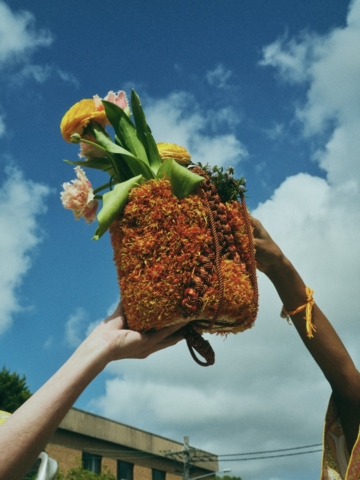Sun, Worship, and The Collective Joy of Sol
By Jo Phillips
It doesn’t surprise me to learn that almost every ancient civilisation had a solar deity. The sun, as we know, gives heat and light, and ancient societies based around agriculture knew to respect (and fear) the thing responsible for the outcome of their harvest. It must have seemed so natural, so self-evident, that this entity was God; the power to bestow light and life, to shift seasons, to be all-seeing – how else to view these extravagant gestures if not the seal of something divine? Find out more in Sun Worship and The Collective Joy of sol by Ben Nobuto
In ancient cultures like Egypt and Mesopotamia the sun’s power was synonymous with royalty; the king ruled by the power of the sun and claimed direct descent from it. Most societies personified the sun as the omniscient eye, the guarantor of justice, and the source of wisdom (light means enlightenment in any culture).
Sun God Ra travelling on his sun boat across the daytime sky.
While predominantly male – Ra (Egypt), Shamash (Mesopotamia), Inti (Inca), Surya (India) – several sun Gods were female, like Sól or Sunna (Germany), Amaterasu (Japan), and Bila and Wala (Australian aboriginal folkore). The sun’s diurnal cycle was commonly depicted, rather sweetly, as a literal voyage across the sky on a sun vessel.
In the summer of 2022 I was asked to write a piece for eight singers for the National Youth Choir. Before I knew what exactly to write about, I had thought of communicating the joy, energy and sense of renewal that I associate with the sun.
I wanted, above all, to convey a kind of immediacy, the sensation of warm sunlight cast on skin, so direct and visceral it feels like a fact. Electronic artist Sophie once described her music as ‘completely overriding your cognitive process,’ which is, in a way, how the sun operates; it becomes ‘a directly centred physical thing.’ To lay in the sun’s path is to feel yourself sweat and pulse; it reminds you that you are alive.
While the solar ideologies of ancient civilisations interested me, I found myself drawn to more native, folkloric images of sun worship: rituals, pagan rites, collective ecstasy.
Some stone circles, I had read, were said to be the petrified remains of heathens punished for dancing on the Sabbath (the most well-known being the Merry Maidens in St Buryan, Cornwall). Taking my cue from this, I pictured the eight singers in the ensemble as sun worshippers, merry maidens gathered on the Sabbath, singing and dancing in cult-formation, delirious, mesmerised, in trance.
‘Sol’ opens with a declaration – ‘sun’ – sung in unison by all eight singers. The piece summons itself into action, using that monosyllabic word like a mantra or primordial call.
There’s a touching moment in Leonard Bernstein’s 1973 Harvard lectures, where he reimagines the primal utterance of Genesis – yehi ‘or יְהִי אוֹר (‘Let there be light’ in Hebrew) – as music rather than just speech: ‘I’ve always had a private fantasy of God singing those two blazing words – yehi ‘or! – now that could really have done it! Music could have caused light to break forth.’ If ‘Sol’ is a creation story, then ‘sun’ is the magic, generative word from which the musical universe springs open.
The first page of ‘Sol’. Fragments of speech taken from overheard conversations around London.
In solfege, a music education system where each note is assigned a syllable, Sol is the name for the fifth scale degree: Do, Re, Mi, Fa, Sol. In the key of C major this note would be G (C, D, E, F, G).
By coincidence then, ‘Sol’ was not just a God but also a sound, a musical pitch. For the first minute of the piece, the first soprano remains fixed to the G while the chords shift beneath her as if anchoring the harmony from above.
Even amidst all the layers the soprano’s G cuts through, due to the way our ears naturally attune to the highest pitch. (Interestingly, the Egyptian sun God Ra also has a solfege-like name, crossed between notes Re and La, and the Incan god Inti almost combines the notes Mi and Ti – as if ancient people named their Gods based on the musicality of the sound).
Wanting to avoid any pre-existing text, I compiled lyrics of one hundred famous environmentally-themed pop songs, such as ‘Big Yellow Taxi’ by Joni Mitchell and ‘Mercy, Mercy Me’ by Marvin Gaye, and then boiled it down to the most commonly used nouns: ‘sun,’ ‘earth,’ ‘time,’ ‘home,’ ‘love,’ ‘sky,’ ‘day’ etc.
After the one-minute mark, this strange, patchwork text is broken up and divided among the eight voices like a hocket, a medieval technique where a melody is shared between multiple voices. It’s interesting how simple the effect is and yet how strikingly artificial it sounds, as if the voices are being sampled electronically.
A hocket made up of the most commonly used nouns in environmentally-themed pop songs since the 1970s. A Hocekt means alternating between parts, single notes, or groups of notes
More than anything literal, what ties ‘Sol’ to sun worship is a raw and reckless kind of joy and effect that I associate with folklore, cults, and paganism.
For me, sun worship offered a chaotic antidote to the always-serene, always-earnest air of much choral music, and opened a door to fun, unconventional ways of producing sound, from speaking and shouting to vocal fry and lip trills (‘blowing raspberries’), to fragile sounds like inhaling/exhaling, whistling and singing microtones (i.e. going ‘out of tune’).
While watching the National Youth Choir rehearse ‘Sol’ in an old chapel last year, I felt a warmth and playfulness in the room and amongst the singers that reminded me of how I felt when I wrote the piece; how I feel under the sun.
‘Sol’ is one of this year’s nominated works at the Ivors Classical Awards, taking place at BFI Southbank on 14th November
You can get to know Ben Nobuto’s work by checking out his website bennobuto.com and his Instagram, and listen to the official recording of ‘Sol’ here on Spotify
If you enjoyed reading Sun Worship and The Collective Joy of Sol, then why not read Opera in a Bottle Here
With thanks to both Ben and Charlotte
.Cent magazine London, Be Inspired; Get Involved







